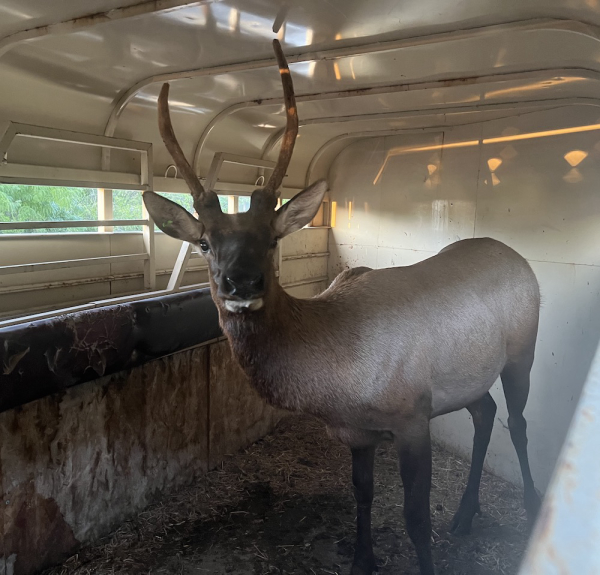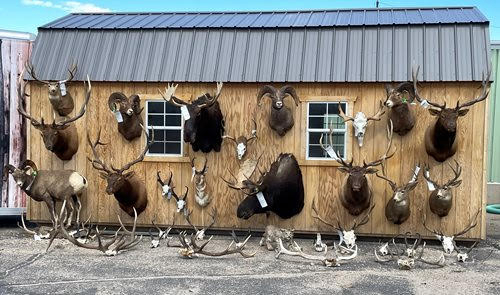F&G Darts and Relocates Young Bull Elk in Boise

The pull of an airgun trigger, the thwap of a dart hitting the rump of an elk, and the barely-above-a-whisper call over the radio: “Dart is in” are all followed by a couple of minutes of quiet observation. One can feel a sense of anticipation from the silence of the assembled enforcement officers and wildlife biologists.
They watch as the elk ambles a few feet, looks back and licks at the dart in its backside a few times, and finally, starts to rock and sway as the immobilizing drug begins to take effect.
It goes down slowly, and then suddenly – and then, one last call over the radio that spurs a flurry of activity: “He’s down.”
The young bull elk that Fish and Game staff darted and relocated from a Boise neighborhood on the evening of Aug. 21 went about as quickly, efficiently, and safely as such an operation can go. Less than 30 minutes separated the deployment of the dart and the moment the elk stood again upright in a horse trailer, awaiting transportation to a release site far away from the bustling intersection of S. Federal Way and E. Bergeson St. near where it was found.
Looking solely at these 30 minutes on a warm August evening in Boise, one might come away with the impression that darting and relocating an animal in real life isn’t so different from the movies. But then, they wouldn’t be seeing the whole picture.
“This went as close to perfect as we could have hoped for, and that’s a testament to the professionalism of our staff,” said Regional Supervisor Josh Royse. “But they don’t all go like this, even when you play them perfectly.”
Weighing the risks
Chemically immobilizing and relocating a wild animal involves inherent risk to the animal, Fish and Game staff, and potentially the public.
Darting and relocating any animal involves the use of potent immobilization drugs, which produce significant physiological effects and carry inherent risks even in a controlled environment — not only for the animal, but also Fish and Game staff. There are very real risks of an animal dying as a result of using an immobilization drug, including those associated with drugs themselves, or from situations that arise before the immobilization drug kicks in (such as an animal running into traffic after being darted). Even in the best of situations, darting wildlife is stressful to the animals.
When Fish and Game does make the decision to dart and move an animal, their staff take every step to mitigate these risks. For this operation, that included working with Boise Police to control traffic and secure the scene, but even with thorough planning, there are variables that simply cannot be controlled. Remember that tense silence as Fish and Game staff waited for the immobilizing drug to take effect? What the elk did in those moments was one such variable.
Uncertainties like this are among the reasons why Fish and Game staff don’t dart and move every wild animal that shows up somewhere unexpected, and instead evaluate all options on a case-by-case basis. There are many components to the decision-making matrix that Fish and Game uses to evaluate whether to chemically immobilize and relocate an animal, but it essentially boils down to this: Are there other options for getting the animal out of the area that involve less risk? And if not, does the risk to public safety of doing nothing outweigh the risk involved with chemical immobilization?
In this case, the answer was relatively straightforward: Hazing or allowing the elk to move out of the area on its own wasn’t an option – there was nowhere safer for the elk to go on it’s own, and it wasn’t safe for it to stay put, either.
“In any cardinal direction this elk could have traveled, it would have presented a substantial public safety risk for a vehicle collision,” Royse explained. “It was in a very bad place, and the only option it had was to move to somewhere worse.”
Doing nothing is sometimes the best answer, but decision-making is dynamic
In many cases, such as with the two moose that have taken up temporary residence in outlying Boise communities, the risks of moving the animal currently outweigh the risks of not doing so. These two moose are hanging out in areas without any major concerns for traffic collisions, have not been reported as showing signs of aggression, and have opportunities to move safely out of the area into connected open spaces.
“There is some risk involved with living in close proximity to any wild animal, including a moose, but the evidence we have tells us that the risk with these moose is low,” Royse said. “We have been actively working to further mitigate that risk, to a level that is less than the risk of darting and relocating, through proactive communication with, and education of area residents.”
That said, the factors that go into Fish and Game’s decision-making are dynamic. When they make an initial decision not to intervene with an animal in town, Fish and Game staff continue to monitor the situation, and routinely reevaluate their decisions as circumstances change.
Even in the moment, the right decision in the interest of public safety can change from hazing or darting and moving an animal to dispatching it.
“When it comes to dealing with wildlife in unsuitably urban areas, every variable in that equation can change on a dime. Our decision-making must be just as nimble and dynamic,” Royse said. “The only truly rigid element of our decision-making process is that we are putting public safety first, followed by the safety of our staff and the safety of the animal.”






